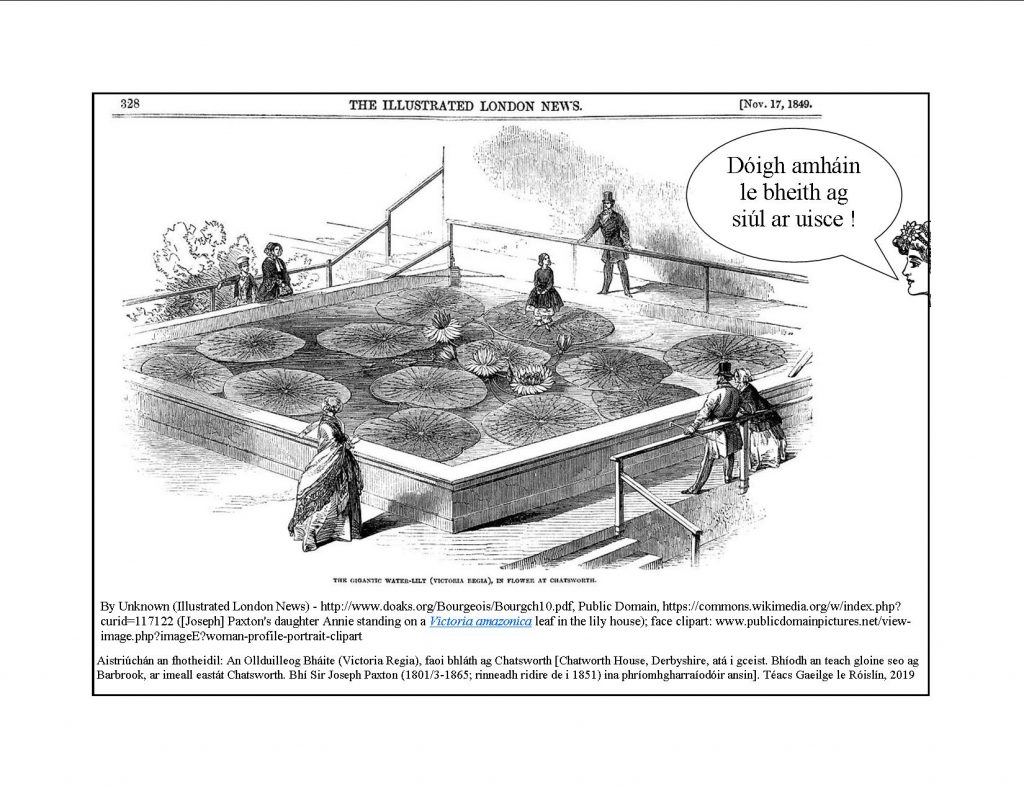Speaking of Water-Lilies, whether you know them as bual-lilí, bior-rósanna, duilleoga báite, or póicíní locha Posted by róislín on Jun 30, 2019 in Irish Language
(le Róislín)
Our most recent post showed some amazingly large water-lilies and looked at the terminology for them. Researching that, I also found the amazing illustration above. Who could resist turning this into a teachable moment – how to say “girl,” “standing,” and “on a water-lily” in Irish? For the second part of today’s blog, we’ll actually look at various forms of the various words for water-lily in Irish. But first let’s try saying “The girl is standing on the water-lily.” Since we have four choices for water-lily, we’ll have four sentences. We’ll say both “standing on the water-lily” and “standing on the pad (duille) of the water-lily,” for additional practice.Tá an cailín ina seasamh / The girl is standing …
1)) ar an mbual-lilí … ar dhuille na bual-lile
2)) ar an mbior-rós … ar dhuille an bhior-róis
3)) ar an duilleog bháite … ar dhuille na duilleoga báite (!)
4)) ar an bpóicín locha … ar dhuille an phóicín locha
And now for “water-lily,” “of a water-lily,” “water-lilies,” etc. Last time we were mostly interested in the variety of concepts embedded in the terms and how they all managed to mean “water-lily” without containing the usual Irish word for water ” (uisce). This time we’ll include the different forms of the phrases and look for real-life examples of their use.
1)) bual-lile, water-lily, bual-lilí, water-lilies, (grammatically feminine)
an bhual-lile, the water-lily, na bual-lilí, the water-lilies
dath na bual-lile, the color of the water-lily; dathanna na mbual-lilí, the colors of the water-lilies.
Using the term “bual-lile,” there is a nice short write-up in Irish on the plant, written for school kids, at: http://www.askaboutireland.ie/learning-zone/primary-students/ar-dtimpeallacht/aibhneacha-agus-locha/flora/bual-lile/
Another interesting use is in a discussion of the food consumed by the residents of a prehistoric settlement at Cill Santail (Mount Sandel), in County Derry: plandaí (cnónna coill, fia-úlla agus síolta na bual-lile (http://cstair.blogspot.com/2018/05/, An mheán-chlochaois, Ar leanúint ón mí seo caite, le Vincent Morley)
2) bior-rós, water-lily, bior-rósanna, water-lilies
an bior-rós, the water-lily, na bior-rósanna, the water-lilies
dath an bhior-róis, the color of the water-lily; dathanna na mbior-rósanna, the colors of the water-lilies
As for a usage in context, I haven’t found much online for “bior-rós,” but lo and behold, “bior-rósanna” popped up in an interesting line in an Irish translation of Joyce’s Ulysses, Chapter 5, which can be found at: http://baoismhachnamh.blogspot.com/2017/06/an-seoigheach.html It’s not even a full sentence, just literally “Bior-rósanna.” It’s preceded by the phrase “Plandaí leochaileacha.” [Sensitive plants] and followed by “Piotail ró-thuirseach le.” [sic — we don’t know “le” what], which was “Petals too tired to.” in the original}. So, no verbs, no complete sentences here, but knowing Joyce, it’s no surprise.
There’s one more reference to a waterlily in Ulysses (according to my search), in Chapter 15, where it says “Bloom, pleading not guilty and holding a fullblown waterlily, begins a long unintelligible speech.” (https://www.gutenberg.org/files/4300/4300-h/4300-h.htm#chap15). Unfortunately I don’t have any access to an Irish translation for Chapter 15, but I’d love to know what Irish phrase the translator or Joyce himself would have used. Bior-rós (for consistency’s sake)? Or one of the other words for water-lily? Anyway, I like the idea that the character’s speech is described as “unintelligible,” which many people might say applies to the novel itself. Or to Joyce’s Finnegans Wake. Ach sin scéal eile!
3) duilleog bháite, water-lily, duilleoga báite, water-lilies
an duilleog bháite, the water-lily, na duilleoga báite, the water-lilies
dath na duilleoige báite, the color of the water-lily; dathanna na nduilleog báite, the colors of the water-lilies
Here are a few places where I’ve found the term “duilleog bháite” used:
a)) a school project of students painting their own versions of Claude Monet’s “Water-Lilies”; the project was named “Na Duilleoga Báite” at https://www.gsnp.ie/gallery/obair-ranga-432/ (Gaelscoil Naomh Padraig, Bóthar an Chaisleáin, Leamhcán, Co. Bhaile Átha Cliath
b)) a phrase in Gabriel Rosenstock’s translation of a haiku about “corra ar eite” (herons flying) at http://roghaghabriel.blogspot.com/2017/07/ Rosenstock uses the prepositional phrase form “sa duilleog bháite.”
c)) in Máire Nic Mhaoláin’s Irish translation (Faoin Sceach Gheal) of Marita Conlon-McKenna’s young adult novel, Under the Hawthorn Tree (1990): “… tríd an bhfiaile in aice na giolcaí nó ina luí go sámh faoi na duilleoga báite.” [my
“retranslation”: through the weeds near the reeds or lying down peacefully under the water-lilies” — that may not be exactly the same as the English original, but it’s a reasonable re-translation].
4)) póicín locha, water-lily, póicíní locha, water-lilies
an póicín locha, the water-lily; na póicíní locha, the water-lilies
dath an phóicín locha, the color of the water-lily; dathanna na bpóicíní locha, the colors of the water-lilies
I’ve found fewer contextual usages for this phrase than for the other terms for “water-lilies” but have at least found this one reference:
póicíní locha, used by Máirtín Ó Cadhain in his 1953 short story collection, Cois Caoláire (according to https://quizlet.com/24767190/cois-caolaire-flash-cards/ by Mac Giobúin, who has also created files for many languages, ranging from “Alutiiqis” (teanga Eiscimea-Ailiútach) to an tSúlúis). Cad is ciall le teideal an leabhair sin? Bhuel, the title has been translated variously as “By the Firth” or “Beside the Bay.” Any readers know what comments Ó Cadhain was making about “póicíní locha” Níl cóis den téacs agam.?
I hope you found this both useful and interesting SGF — Róisín

Build vocabulary, practice pronunciation, and more with Transparent Language Online. Available anytime, anywhere, on any device.





Leave a comment: